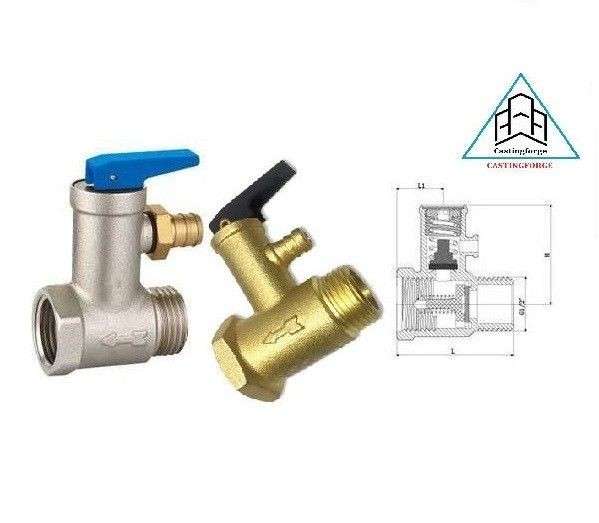
Jul 26,2023
When it comes to home appliances, water heaters are essential for providing hot water for various daily activities. While they are reliable devices, it's crucial to prioritize safety measures to prevent potential hazards. One crucial component that ensures the safety of your water heater is the safety valve. In this article, we will explore the importance of the water heater safety valve, how it works, signs of malfunction, testing procedures, maintenance tips, and the possibility of upgrading to advanced safety features.
The water heater safety valve, also known as the pressure relief valve, is a critical safety component installed in all water heaters. Its primary purpose is to relieve excess pressure that builds up inside the water tank. As water is heated, it expands, leading to an increase in pressure within the closed system. Without a safety valve, the pressure could reach dangerous levels, potentially causing the water heater to explode or rupture.
The water heater safety valve is a simple yet effective device. It consists of a spring-loaded valve mechanism connected to a discharge pipe. When the pressure inside the water tank exceeds the preset limit, the spring compresses, allowing the valve to open. This action releases the excess pressure through the discharge pipe, preventing any catastrophic failures.
Like any mechanical component, the water heater safety valve may experience wear and tear over time, leading to potential malfunctions. It is crucial to be aware of the signs that indicate a faulty safety valve. Some common signs include:
Continuous Dripping: If you notice water constantly dripping from the discharge pipe, it may indicate that the safety valve is not sealing properly or that it needs replacement.
Noisy Operation: A malfunctioning safety valve can produce unusual noises, such as whistling or hissing, when the water heater is in operation.
Leakage around the Valve: Any signs of leakage around the safety valve area could be an indication of a problem.
Inability to Hold Pressure: If the safety valve fails to release excess pressure or cannot maintain the correct pressure level, it needs immediate attention.
Regularly testing the water heater safety valve is essential to ensure it functions correctly. Follow these steps to perform a simple test:
Turn Off the Power: Before testing, ensure the power supply to the water heater is turned off to avoid accidents.
Locate the Safety Valve: Identify the safety valve, typically found on the top or side of the water heater.
Prepare a Bucket: Place a bucket beneath the discharge pipe to catch any water that may be released during the test.
Lift the Valve Lever: Carefully lift the lever on the safety valve for a few seconds and then release it. Doing so should trigger a slight rush of water into the bucket.
Observe the Valve: Check if the valve closes properly after releasing the lever. It should stop water flow immediately.
Contact a Professional: If the valve fails to release water during the test or doesn't close correctly, it's best to contact a professional plumber to inspect and repair the valve.
To ensure the longevity and proper functioning of the water heater safety valve, regular maintenance is essential. Here are some maintenance tips:
Flushing the Tank: Regularly flush the water heater tank to remove sediment and mineral buildup, as this can affect the safety valve's performance.
Inspect Annually: Have a professional plumber inspect the safety valve annually to ensure it is in good condition.
Replace as Needed: If the safety valve is damaged or shows signs of wear, promptly replace it with a new one.
While traditional safety valves are effective, technology has brought about advanced safety features for water heaters. Consider upgrading to the following options for enhanced safety:
Temperature and Pressure Relief Valve (TPR Valve): This valve monitors both temperature and pressure, providing more comprehensive protection.
Intelligent Water Heater Controllers: These devices allow remote monitoring of water heater operations and can alert you of any anomalies, including safety valve issues.
Leak Detection Systems: These systems can detect water leaks around the water heater, helping prevent potential disasters.
A: It is recommended to test the safety valve at least once every six months.
A: While some homeowners may be comfortable doing it themselves, it is best to have a qualified professional handle the replacement to ensure it's done correctly.
A: Yes, investing in advanced safety features provides an extra layer of protection for your family and home.
A: While safety valves are crucial, regular maintenance and responsible use of the water heater are also essential for accident prevention.
A: If you notice any leakage from the safety valve, contact a professional plumber to inspect and address the issue.
Understanding the significance of the water heater safety valve is crucial for ensuring your family's safety and avoiding potential disasters. Regularly testing, maintaining, and, if needed, upgrading the safety valve will provide peace of mind and contribute to the efficient and safe operation of your water heater. Prioritizing these safety measures is a small effort that goes a long way in protecting your loved ones and your home.